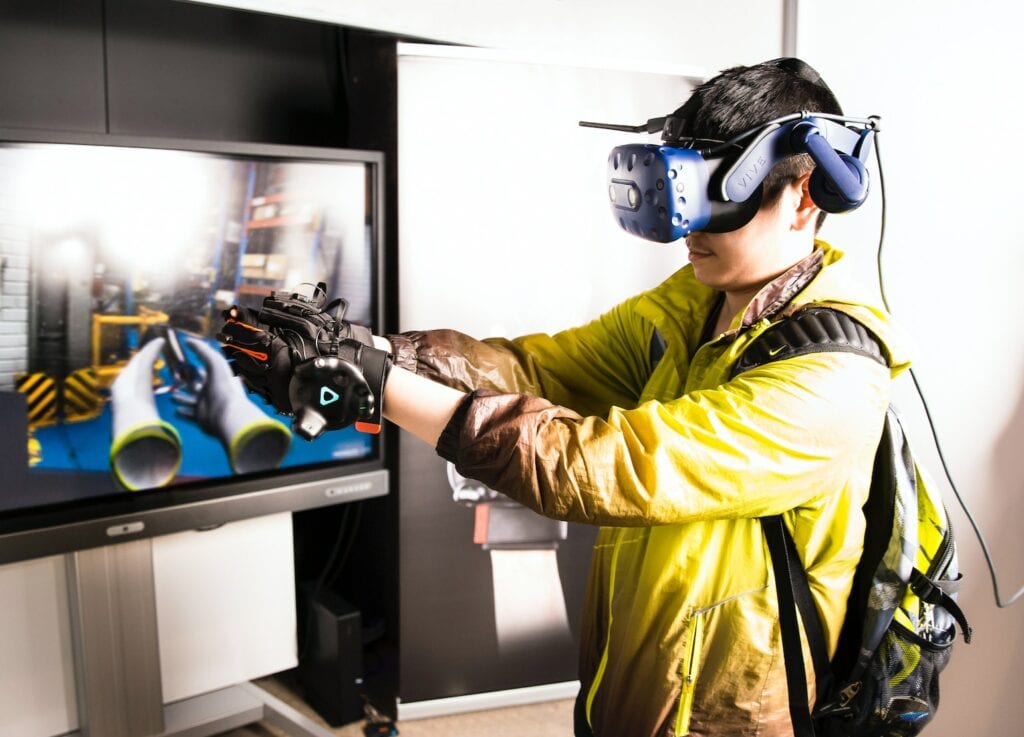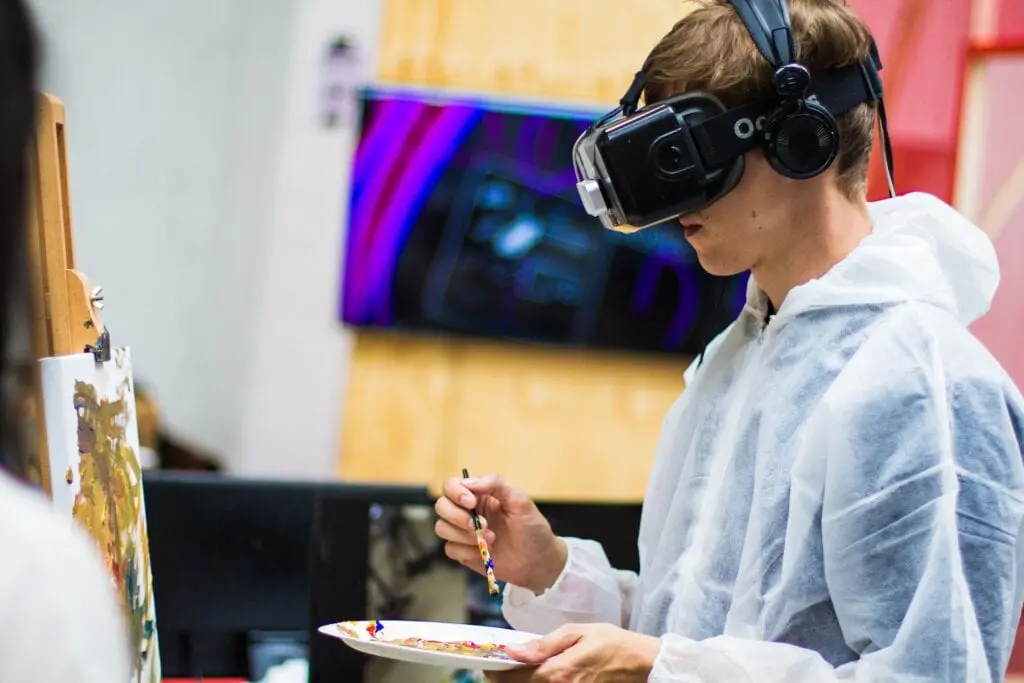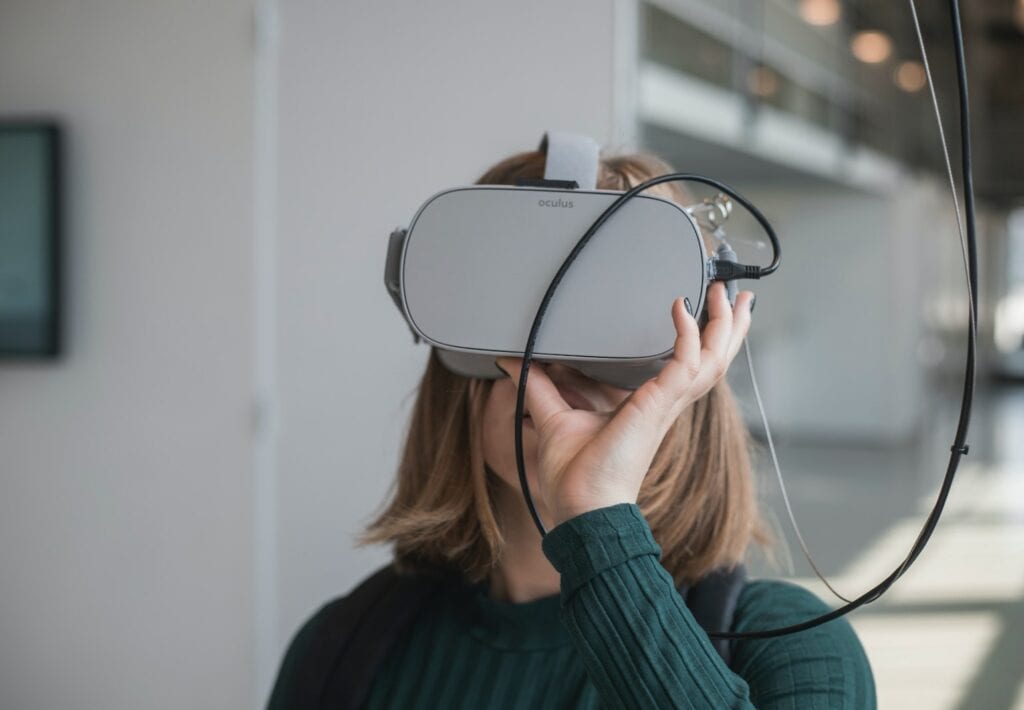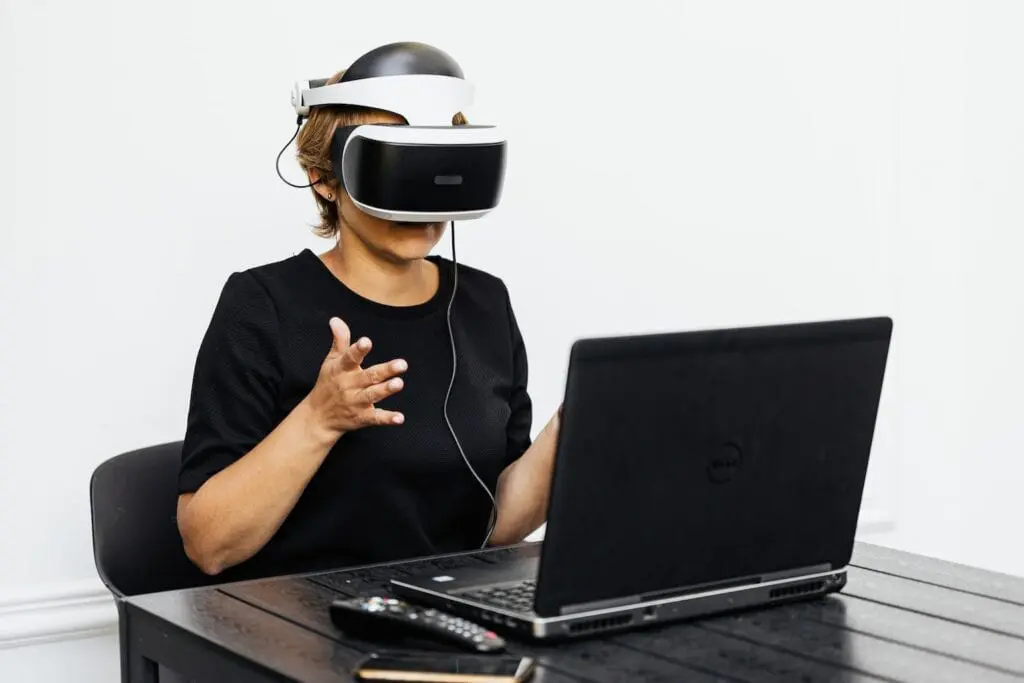What is virtual reality? Commonly abbreviated VR, it isn’t just for gamers these days. VR and AR (augmented reality) can be used to immerse you into completely new worlds—or enhance the real world—to help with job training, healthcare, art, and much more.
In this article, I’ll break down what virtual reality is; what VR is used for; how VR works, the differences between VR, AR, and MR (mixed reality); where the future of VR is heading; plus some resources to help you learn VR and related technologies.
Let’s dive in!
Table of Contents
- What Is Virtual Reality (VR)?
- What Is VR Used For?
- How Does VR Work?
- What Is The Future of VR?
- VR Job Opportunities
- Where to Learn More About VR
Disclosure: I’m a proud affiliate for some of the resources mentioned in this article. If you buy a product through my links on this page, I may get a small commission for referring you. Thanks!
What Is Virtual Reality (VR)?
Let’s start at the beginning and define virtual reality! 👇
Virtual reality definition: A computer-generated simulation that people can interact with in a 3D (three-dimensional) environment using physical devices and wearables like smart phones, special goggles, headsets, gloves with sensors, etc. It typically includes auditory and video elements, but may also include other types of sensory feedback through haptic technology (i.e., any technology that allows you to “feel” something), such as through vibrations.

Now, let’s cover a little of the history of virtual reality. When was virtual reality invented? Despite how futuristic VR still sounds, its first incarnation might be earlier than you think. Virtual reality technology was invented in 1957 by Morton Heilig, a cinematographer who invented the Sensorama — an immersive, multi-sensory movie theater device. It simulated a motorcycle ride through New York (it even triggered the smell of pizza using chemical odor emitters!).
However, the term “virtual reality” wasn’t coined until 30 years later in 1987 by researcher Jaron Lanier. You can read more about the history of virtual reality here.
Another important thing to know is that there are different types of VR technology: full virtual reality, augmented reality, and mixed reality.
- Virtual reality (VR): Places you into a new world/location entirely. Usually does not incorporate any physical elements of the real world. Think Oculus Rift.
- Augmented reality (AR): Superimposes a computer-generated image onto the real world through a screen. Think Pokémon GO and furniture apps that let you see what a certain couch will look like (and if it will fit) in your actual living room.
- Mixed reality (MR): Combines the virtual environment with the real-world environment. Allows you to interact with both worlds at the same time. Commonly used in job training.
Collectively, all of these technologies are known together as extended reality, or XR.
☝️ Back to the table of contents
What Is VR Used For?
There are tons of virtual reality uses and applications. You might commonly know it as a form of entertainment through video games and fun interactive experiences. But there are other ways that VR is used beyond gaming.
Here are a few fascinating virtual reality examples that already exist in the real world:
- 🎮 Entertainment: Probably the first thing you think of when you think of VR. For example, you can visit Disney World in the comfort of your own home, play games in immersive environments, take a ride on a roller coaster simulator, etc.
- 🏫 Education/job training: VR can also help people train for jobs in a safer, less risky environment. For example, car mechanics can use VR to practice the assembly and disassembly of an automobile. The military has been using VR since the 1990s to train its service members on how to handle high stress situations and learn different combat techniques.
- 🏥 Healthcare: Doctors, nurses, and other healthcare professionals can use VR as training to work on real human bodies. It can also help to relax patients and gamify physical therapy to improve speed up recovery.
- ✈️ Travel: With VR, you can actually feel like you’re in a tropical destination, “travel” to different landmarks, and take virtual tours of different locations or even hotels you’re thinking about booking.
- ⚖️ Courtrooms/legal: Using VR, jurors can “see” crime scenes in 3D, help experts reconstruct events, etc.
- 🎨 Art: VR can also be used to help artists create in new and exciting ways. The Tilt Brush by Google, for example, lets you paint in a 3D space. Your room becomes your canvas.

As you can see, these virtual reality applications are already improving the way people live and work!
☝️ Back to the table of contents
Start coding now
Stop waiting and start learning! Get my 10 tips on teaching yourself how to code.
How Does VR Work?
Interested in VR systems themselves and how virtual reality works? Here’s a brief look at the virtual reality technology that puts everything together.
Since VR simulates human vision, a VR headset puts up a screen for each eye. Two “autofocus” lenses are also placed between the screen and your eyes to help adjust based on your eye movement and positioning. The visuals you see are rendered by a mobile phone or HDMI cable connected to a PC or TV.

To make the experience more realistic, VR headsets aim to create a field of view (FOV) that is similar to a human’s. An average human can see around them in a 200 to 220-degree arc around their head. VR headsets can only do a 114-degree arc, but work is being done to achieve an 180-degree arc.
Frame rate is also important in VR. Frame rate is the number of frames per second (FPS) the human eye can see. Humans can generally see 30 and 60 frames per second. The frame rate for movies is 24 FPS, but for VR, the frame rate needs to be at least 60 FPS to avoid disorientation and nausea. Many developers aim for between 90 FPS and 120 FPS to create the most realistic VR experience.
Other important elements of VR are sound, and eye and head tracking.
When it comes to sound, something called “spatial audio” is used to create a simulated audio landscape based on visuals.
Motion tracking involves something called DoF, which stands for “degrees of freedom.” There are currently two types: 3DoF and 6DoF.
- With 3DoF, you can look left and right, look up and down, and pivot left and right, but it won’t pick up whole body movements.
- If you want to actually walk through an environment, 6DoF is needed. This allows you to move forward and backward, up and down, and right and left. You can also interact with objects placed in the environment.
For developers looking to get into VR development, common languages include C#, C++, Java, JavaScript, and Python.
☝️ Back to the table of contents
Want to master Python?
Then download my list of favorite Python learning resources.
What Is The Future of VR?
So where is VR heading? With COVID-19 restricting us from going out as much in 2020, VR has been experiencing a big rise to make up for going out in “real life.” According to research, the global virtual reality market size is expected to grow to 62.1 billion dollars by 2027.
Some other parts of the future of virtual reality technology to look forward to:
- More lifelike field of view
- Better 3D spatial audio
- More realistic touch sensations through haptic devices like the HaptX Gloves
- Foveated rendering (a technique which uses an eye tracker to render ultra-high definition images)
- And more

Some possible virtual reality uses we’ll see in the near future include:
- Pain relief
- Immersive distance learning
- Advanced VR training for different professions
- Enhancing work from home experiences
We’ve only just started seeing the benefits of virtual reality in action.
☝️ Back to the table of contents
VR Job Opportunities
Here are a few VR-related careers, along with their average salaries:
- Software engineers can specialize in virtual reality technologies to actually help build VR experiences. May sometimes be referred to as “Unity developers” (if specializing in Unity) “VR engineers,” etc. The average salary of a software engineer is $105,502 per year.
- Product designers create designs, prototypes, and concepts for AR/VR applications, hardware products, and/or interaction models. Product designers earn $116,361, on average.
- Virtual reality testers may test gaming equipment and ensure VR headsets are up to specifications, or they may actually test the software behind VR applications. Software test engineers earn $94,488/year on average.
- UX/UI engineers help design the experience and user interface of VR applications and games. UX/UI engineers working in VR may need to know Unity 3D, Maya, and Photoshop. Average salary: $96,780/year.
- Computer vision engineers help computers process visual data and recognize their surroundings. They work on VR tasks like developing algorithms for object tracking. Computer vision engineers earn $132,708 per year, on average.
☝️ Back to the table of contents
Where to Learn More About VR
Are you thinking about getting into the field of virtual reality yourself? Virtual reality market growth has never been higher, so it’s a great time to start gaining skills that will get you a job at the virtual reality companies doing exciting things.
- Virtual Reality Specialization by University of London (via Coursera): A five-course learning path that teaches you the basics of 3D graphics, the hardware and history of VR, and how to create your own VR game or project.
- VR Development Fundamentals With Oculus Quest 2 And Unity on Udemy: In this course, learn how to build VR experiences with Unity’s XR Interaction Toolkit. By the end, you’ll be able to prototype your Oculus Quest and Quest 2 game/app.
- Introduction to Virtual Reality by Google VR (via Udacity): No programming experience required. Learn about the principles of VR technology including optics, displays, stereopsis, tracking, and major hardware platforms.
- Learning Virtual Reality: Developing Immersive Experiences and Applications for Desktop, Web, and Mobile by Tony Parisi (via Amazon): A book that helps you gain a working knowledge of VR development through clear and simple examples. Covers Unity3D, stereo rendering, how to build a 360-degree panoramic photo viewer, and much more.
☝️ Back to the table of contents
Virtual Reality & You
VR is a good field to get into — especially now. There are tons of different industries using VR right now, and if they’re not using it yet, they surely will be in the future. Within the next decade or two, there might be virtual reality companies doing things we can only dream of now!
Ultimately, it’s an exciting field with lots of applications that will make a real difference in the world. If you’re looking to get into a useful, exciting, and future-proof career, virtual reality might be the perfect fit.
Note: This article contains Amazon affiliate links. As an Amazon Associate, I earn from qualifying purchases.

